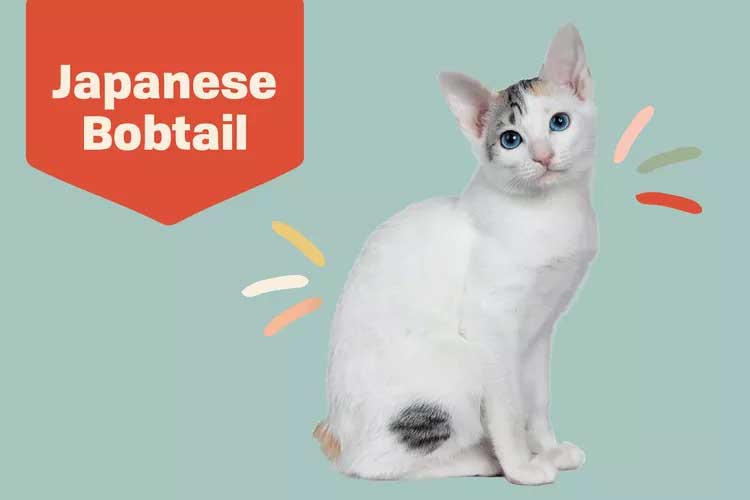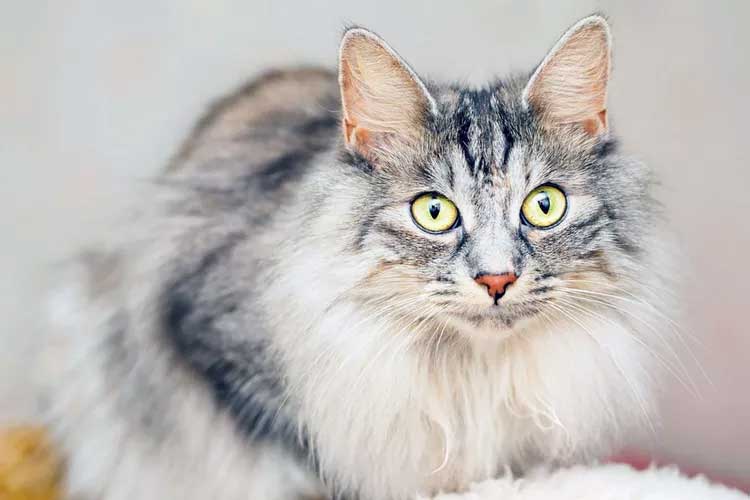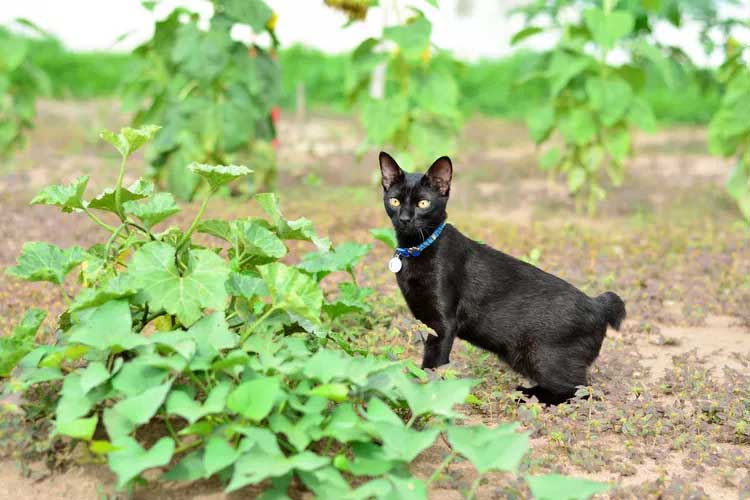Japanese bobtail cats are known for their short tails and playful personalities. This breed makes wonderful family pets. Learn more about owning a Japanese bobtail.

Japanese Bobtail Overview
| OFFICIAL NAME | Japanese Bobtail |
| COMMON NAME | Japanese Bobtail |
| PET HEIGHT | 8 to 9 inches |
| PET WEIGHT | 6 to 10 pounds |
| LIFESPAN | 9 to 15 years |
| GOOD WITH | cats, children, dogs, families, seniors |
| TEMPERAMENT | affectionate, bold, sociable |
| INTELLIGENCE | high |
| SHEDDING AMOUNT | seasonal |
| PLAYFULNESS | high |
| ENERGY LEVEL | hyper |
| VOCAL LEVEL | frequent |
| COAT LENGTH | long, short |
| COLORS | black / ebony, blue / gray, chocolate / brown / sable, cream / beige / tan, lavender / silver, red / orange, white |
| PATTERNS | bi-color, calico / tri-color, solid, tabby |
| OTHER TRAITS | easy to groom, easy to train, friendly toward humans, friendly toward other pets, friendly toward strangers, good for first-time pet owners, high potential for weight gain, tolerates being picked up |
Japanese bobtails are prized for their short and kinked tails, outgoing personalities, and athletic abilities. This captivating breed is native to Japan but known around the world.
These energetic animals make wonderful pets and are especially good with children. Japanese bobtails love to be the center of attention and are a huge part of family life. They're also low-shedding, easy to groom, and super intelligent.
These cute, quirky cats are relatively rare. Because Japanese bobtail cats are uncommon, they typically cost between $600–$1,600 from a responsible breeder.
Appearance
The defining physical characteristic of the Japanese bobtail is, of course, the cat's bobbed tail. It resembles that of a rabbit, rather than your typical cat. These pets' stubby tails are usually no longer than 3 inches long, covered in tufts of fur, and curled or kinked to one side."Just like fingerprints, no two tails within this breed are the same," says Natalie L. Marks, DVM, CVJ and Royal Canin veterinarian partner.

The Japanese bobtail is a medium-sized cat that weighs 5–10 pounds, with males typically weighing more than females. They have long, lean torsos and strong, muscular bodies. Their back legs are slightly longer than their front legs, and they have high cheekbones, oval eyes, and long noses.
Japanese bobtails have two coat types: long and short. The coat can be solid, bi-color, calico, or tabby, but this breed is most commonly white with colored spots, known as the van pattern. Both long and short coats are silky smooth, easy to groom, and low-shedding. However, although Japanese bobtails usually shed less than other breeds, they do have shedding seasons in the spring and fall and are not considered to be hypoallergenic cats.
Temperament
Japanese bobtails are outgoing, friendly, and highly intelligent. This breed is known to get along well with kids, dogs, and other cats, says Marianne Clark, secretary of the Cat Fanciers' Association Japanese Bobtail Breed Council. They're charming, people-loving pets who adore human attention and love to socialize."Owners of Japanese bobtails consider them the smartest, sweetest cats with their endearing clown activities, affectionate kisses and hugs, the demand to be with us in our activities, and their dog-like habit of following people around," Clark says. "We're not surprised if one pops out of a kitchen cabinet or deftly opens up a door."

Compared to most kittens, Japanese bobtails become active young and remain active for the majority of their lives. These cats have tons of energy to spare, and they use it to turn any time into playtime, according to the Cat Fanciers' Association (CFA). Athletic bobtails love to bring toys to their pet parents to initiate play and work out some of that pent-up energy.
"Fetching is one of their passions, and we don't need to teach them," Clark says. "We are kept young by their silliness."
Your Japanese bobtail may have somewhat of an independent streak. These feisty cats are not easily intimidated and naturally assume dominion over their living spaces. Because of this, Japanese bobtails can be demanding of your time and attention, as well as nosy and always involved in your everyday tasks. They're not lap cats, but they do love to be near you anytime, all the time. As Clark says, "these are no couch potatoes."
Living Needs
As said, the Japanese bobtail needs lots of attention. This breed wants to be in the middle of family life and become a true member of the group. They love their people and take it upon themselves to "help" their owners with everything from typing emails to making the bed, the CFA says.These friendly, social cats love to ride on people's shoulders and greet guests at the door. You won't need to listen carefully to hear your bobtail's sounds since they're super chatty and love to vocalize. They have sweet, sing-song voices and will almost always reply when spoken to.
Your bobtail is likely to get along with every member of the house. Guests, other pets, and children will all be considered new playmates for these vivacious kitties—and playmates are very dear to these active, energetic cats. You may even consider getting Japanese bobtails in pairs.
These cats are particularly good with kids and make adoring, entertaining family pets. They're an interactive breed, so expect them to initiate play frequently by bringing you toys, according to the CFA. Japanese bobtails love to jump, pounce, and wrestle with playmates. They tend to be the leaders of the pack when it comes to the rest of the family pets.

Because they're so social, Japanese bobtails don't do well when left alone for long periods of time. This breed craves interaction above all. The good news is the Japanese bobtail typically travels well and will happily join busy pet parents on the road.
Care
"Grooming is relatively easy with this breed," Marks says. "They have no undercoat—the recommendation is just to brush once weekly to remove dead hairs."Because there is no undercoat, both short- and long-hair Japanese bobtails aren't prone to matting. Yet while your pet will require minimal daily care, you'll probably need to brush him more during spring and fall shedding seasons.
Athletic, agile Japanese bobtails enjoy moving and don't need a lot of outside motivation to exercise. Japanese bobtails are intelligent animals who love to learn. Beyond the basics of litter box training and scratching post training, you can work on teaching some tricks to your cat. They especially love competing in cat shows and showing off their tricks. If you're not really a cat show-type of owner, providing your pets with interactive toys and engaging with them one-on-one will help keep them moving.
Japanese bobtails are a bold breed who take to socialization fairly easily, but early introductions to people and other pets are a good way to ensure socializing goes smoothly with your new kitten.
Your cat should be fed a diet of high-quality cat food recommended by your vet. Japanese bobtails love to snack, and their active lifestyles don't always prevent obesity. Monitor your bobtail's treat and food intake to prevent him from becoming overweight.
Health
Japanese bobtail cats have a lifespan of 9–15 years. This strong, natural breed is typically healthy and disease-resistant.While the Japanese bobtail's tail is the result of a genetic mutation, that mutation is not known to result in any specific health issues for this breed. Reputable breeders will screen for health issues in your kitten, but it's important to have them screened regularly into adulthood. Some health problems can go undetected until later in your cat's life.
History
The Japanese bobcat is a natural breed native to Japan and Southeast Asia. This ancient breed has been recorded in Japan as early as the 6th century and has been featured in art throughout the ages, according to the CFA. Antique woodcuttings and paintings on display in Japanese temples depict the bobtail as a beloved and revered animal.
The Japanese bobtail has a history of domestic and working practicality. These cats were often used as rodent control at silkworm farms at a time when the rat population was threatening the lucrative silk trade. They were also so loved by the imperial family of China that at one point the bobtail was considered a part of the ruling class and a luxury pet not afforded to the common people.
The Japanese bobtail was introduced to the United States in the 1960s and remains a relatively rare breed outside of their homeland.
"There are very few breeders, so choice is limited," Clark says. "Many people want the [calico], which is the good luck cat of Japan. … I also suggest that a person consider [adopting] a retired show cat. A show cat has a proven personality, likes lots of people, and is used to traveling."
Fun Facts
Japanese bobtails are considered good luck. The breed is famously featured in Japanese statues and ceramic figurines known as maneki-neko (which means "beckoning cat") and is thought to attract good fortune.Sanrio's iconic cartoon cat character Hello Kitty draws inspiration from the Japanese bobtail breed.